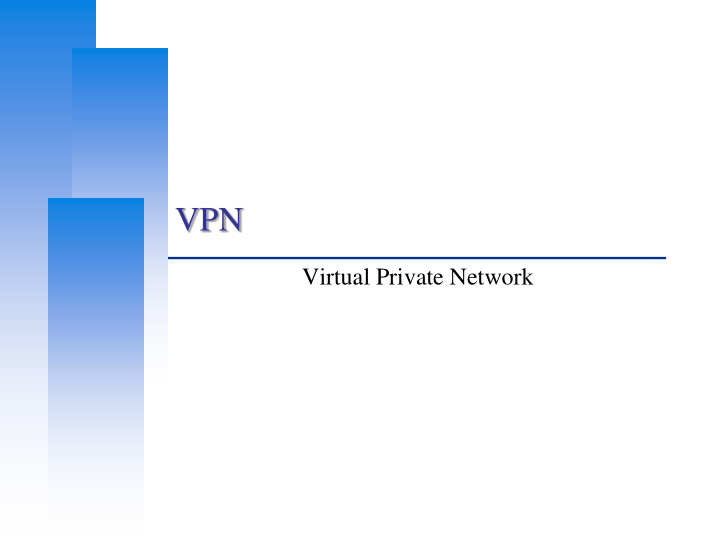



VPN Virtual Private Network
Computer Center, CS, NCTU What is VPN Extension of a private network that encompasses links across shared or public networks like the Internet. Enable to send data between two computers across a shared or public internetwork in a manner that emulates the properties of a point-to-point private link. 2
Computer Center, CS, NCTU Why ? Cheap • Legacy private network uses remote connectivity through dial-up modems or through leased line connections, it’s expensive. Scalable • Extending a leased line connection is complex. • Easy to administer. Security • Provide encryption and file integrity. 3
Computer Center, CS, NCTU Common Uses of VPNs – 1 Remote Access Over the Internet 4
Computer Center, CS, NCTU Common Uses of VPNs – 2 Connecting Networks Over the Internet (Site to Site VPN) 5
Computer Center, CS, NCTU Common Uses of VPNs – 3 Connecting Computers over an Intranet 6
Computer Center, CS, NCTU Basic VPN Requirements User Authentication Key Management Address Management Data Encryption 7
Computer Center, CS, NCTU Basic VPN Requirements – 1 User Authentication • Verify the VPN client's identity and restrict VPN access to authorized users only. • Provide audit and accounting records to show who accessed what information and when. • X . 509, pre- share key…. Key Management • Generate and refresh encryption keys for the client and the server. • Simple Key Management for IP, ISAKMP/Oakley … 8
Computer Center, CS, NCTU Basic VPN Requirements – 2 Address Management • Assign a VPN client's address on the intranet and ensure that private addresses are kept private. Data Encryption • No one outside the VPN can alter the VPN. • Data carried on the public network must be rendered unreadable to unauthorized clients on the network. 9
Computer Center, CS, NCTU Tunneling VPN consists of a set of point to point connections tunneled over the Internet. In order to achieve tunneling, the packets are encapsulated as the payload of packets. • Payloads, to and from addresses, port numbers and other standard protocol packet headers • As seen by the external routers carrying the connection 10
Computer Center, CS, NCTU Common Implementations Point-to-Point Tunneling Protocol (PPTP) [RFC 2637] Layer Two Tunneling Protocol (L2TP) [RFC 2661] IPSec Tunnel Mode [RFC 2401] Secure Socket Tunneling Protocol (SSTP) [Spec] BGP/MPLS IP VPN [RFC 4364] SSL VPN …, etc 11
Computer Center, CS, NCTU PPP Point-to-Point Protocol [RFC 1661] PPP was designed to send data across dial-up or dedicated point-to-point connections. • PPP encapsulates IP, IPX, and NetBEUI packets within PPP frames, and then transmits the PPP-encapsulated packets across a point-to- point link. User Authentication • Password Authentication Protocol (PAP) • Challenge Handshake Authentication Protocol (CHAP) • M$ Challenge Handshake Authentication Protocol (M$-CHAP) • M$-CHAPv2 Data can be compressed or encrypted before transmission. • Microsoft Point to Point Compression / Encryption (MPPC / E) 12
Computer Center, CS, NCTU PPTP Point-to-Point Tunneling Protocol • PPTP doesn’t describe encryption or authentication Rely on the PPP protocol • PPTP encapsulates PPP frames in IP datagrams for transmission over an IP internetwork by TCP connection. • PPTP uses a modified version of Generic Routing Encapsulation (GRE) to encapsulate PPP frames for tunneled data. 13
Computer Center, CS, NCTU Security of PPTP PPTP has been the subject of many security analyses and serious security vulnerabilities have been found • MS-CHAP is fundamentally insecure. • MS-CHAPv2 is vulnerable to dictionary attack on the captured challenge response packets. EAP-TLS (Extensible Authentication Protocol – TLS) is the superior authentication choice for PPTP. 14
Computer Center, CS, NCTU L2TP Layer Two Tunneling Protocol • PPTP+L2F (Layer Two Forwarding) • L2TP over IP internetworks uses UDP and a series of L2TP messages for tunnel maintenance. • A tunnel can contain multiple connection at once. 15
Computer Center, CS, NCTU L2TP/IPsec Usually use IPsec ESP (Encapsulating Security Payload) to encrypt the L2TP packet. • Data encryption begins before the PPP connection process by negotiating an IPSec security association. • Require computer-level authentication using computer certificates. 16
Computer Center, CS, NCTU IPsec Tunnel Mode Internet Protocol Security Tunnel Mode • IPSec tunnel mode encapsulates and encrypts entire IP packets, and the encrypted payload is then encapsulated again with a plain-text IP header. Internet Key Exchange (IKE) • ISAKMP+OAKLEY Two functions that ensure confidentiality: • Authentication Header (AH) Provide source authentication and integrity without encryption. • Encapsulating Security Payload (ESP) Provide both data authentication, data integrity and data encryption. 17
Computer Center, CS, NCTU SSL VPN A form of VPN that can be used with a standard Web browser. The traffic is encrypted with the SSL protocol or Transport Layer Security (TLS) protocol. 18
Computer Center, CS, NCTU Appendix Seven Myths about VPN Logging and Anonymity https://technet.microsoft.com/zh-tw/library/bb742566.aspx 19
Recommend
More recommend